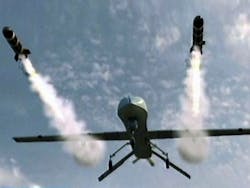Air Force ready to approach industry for enabling technologies in affordable attack drones
Officials of the Air Force Research Laboratory at Wright-Patterson Air Force Base, Ohio, are notifying industry of the upcoming Low-Cost Attritable Aircraft Technology project.
A formal broad-agency announcement for this program, BAA-AFRL-RQKP-2015-0004, will be issued in the near future, researchers say. No further information about when the solicitation will be issued is available.
The goal is to develop unmanned aerial vehicle (UAV) technology that can lend itself to large-scale aerial attacks in remote regions where forward basing is difficult or impossible, researchers say.
For this kind of engagement, Air Force researchers want enabling technologies for affordable UAVs able to carry out long-range and high-speed attacks that are of sufficiently low cost that loss of these aircraft in battle could be tolerated, researchers say.
Related: Electro-optical sensor payloads for small UAVs
Tight defense budgets and many kinds of military threats throughout the world make it imperative for the Air Force to make dramatic reductions in the costs of attack UAVs to bring mass to the engagement, and increase defensive costs to potential adversaries.
Researchers want to trade the relatively high costs of UAV performance, design life, reliability, and maintainability for low-cost attritable aircraft intended for reuse with limited life and number of sorties.
The goal of this program is to establish a benchmark, concluding in a flight demonstration that will test the bounds of what can be accomplished in a short time to establish a baseline system cost against a notional set of strike vehicle requirements, researchers say. Air Force officials expect to award one 30-month contract worth about $7.5 million.
Email technical questions or concerns to the Air Force's Peter Flick at [email protected], Bill Baron at [email protected], or Craig Nelson at [email protected].
Email contracting questions to James Patterson Jr. at [email protected] or Eric Carlin at [email protected].
More information is online at https://www.fbo.gov/spg/USAF/AFMC/AFRLWRS/BAA-AFRL-RQKP-2015-0004/listing.html.
